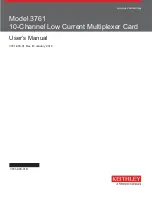
4
Specifications
Screen: LCD, 1999 (3.5 digits) with automatic
polarity indication
Measuring method: dual-slope integration via an
A/D converter
Reading frequency: 2–3× per second
Operating temperature and humidity: 0 °C to 40 °C,
<75 %
Storage temperature and humidity: -10 °C to
50 °C, relative humidity <85 %
Power supply: 1× 9 V (6F22) battery
Fuses: F 250 mA/300 V, ø 5×20 mm, F 10 A/300 V,
ø 5×20 mm
Low battery: indication via a battery symbol on
the screen
Indication of exceeded range: shows „OL“ on the LCD
Measuring category: CAT III (300 V)
Enclosure: IP20
Dimensions 28 × 138 × 70 mm
Weight: 141 g (battery included)
Accuracy
The stated accuracy is for a period of one year since
calibration of the device at 18 °C to 28 °C and relative
humidity of up to 75 %.
Measurement accuracy is stated as: ± [(% of reading)
+ (lowest valid digits)].
DC Voltage
Range
Resolution
Accuracy
200 mV
100 µV
±(0.5 % + 5)
2 V
1 mV
±(0.8 % + 5)
20 V
10 mV
200 V
100 mV
300 V
1 V
±(1 % + 5)
Input impedance: 1 MΩ
Maximum input voltage: 300 V DC
AC Voltage
Range
Resolution
Accuracy
200 V
100 mV
±(1.2 % + 10)
300 V
1 V
Frequency range: 40 Hz to 400 Hz
Maximum input voltage: 300 V AC
Note: The value is an average corresponding to the
calibrated effective sine wave.
Direct current (DC)
Range
Resolution
Accuracy
20 µA
0.01 µA
±(1.2 % + 5)
200 µA
0.1 µA
±(1 % + 5)
2 000 µA
1 µA
20 mA
10 µA
200 mA
100 µA
±(1.2 % + 5)
10 A
10 mA
±(2 % + 5)
Overload protection:
µA and mA range: F 250 mA/300 V fuse
10 A range: F 10 A/300 V fuse
Maximum input current:
socket: max. 200 mA
10 A socket: max. 10 A
When measuring currents larger than 2 A: meas-
urement duration must be max. 10 seconds and
measurement may only be repeated again after
15 minutes!
Resistance
Range
Resolution
Accuracy
200 Ω
0.1 Ω
±(1.2 % + 5)
2 kΩ
1 Ω
20 kΩ
10 Ω
200 kΩ
100 Ω
2 MΩ
1 kΩ
Voltage of an open circuit: max. 1 V
Diode and Circuit Continuity Test
Range
Description
Note
The approximate voltage
of the diode in the
direction of the current
flow will appear on the
screen.
Voltage
without
load: 2.2 V
Built-in buzzer indicates
that resistance in the
circuit is lower than 20 Ω.
If resistance is between
20 Ω and 150 Ω the buzzer
may or may not sound.
If resistance is higher than
150 Ω, the buzzer will not
sound.
Voltage
without
load: 2.2 V
Measuring Direct Voltage
1. Connect the plug of the red measuring conduc-
tor into the
socket and the black conductor
into the COM socket.
2. Turn the circular switch to function marked
. Choose a measuring range and place the
measuring tips the spot or circuit where you
wish to measure DC voltage.
If you do not know the voltage range before-
hand, set the highest possible range and gradually
decrease it as you measure.
3. Turn on the device you want to measure. The
screen will display the voltage value and polarity
relative to the red measuring tip.
If you exceed the range of 300 V, immediately
stop measuring. Otherwise, you risk damaging the
multimeter and suffering injury by electric current.
Measuring Alternating Voltage
1. Connect the plug of the red measuring conduc-
tor into the
socket and the black conductor
into the COM socket.
2. Turn the circular switch to function marked
. Choose a measuring range and place the





































